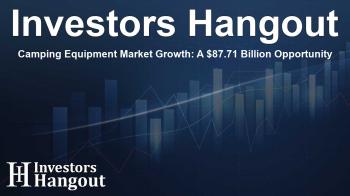Camping Equipment Market Growth: A $87.71 Billion Opportunity

Exploring the Expanding Camping Equipment Market
The camping equipment market is experiencing a remarkable ascent, with projections indicating a staggering valuation of US$ 87.71 billion by 2033. This growth trajectory is underscored by a compound annual growth rate (CAGR) of 7.7% anticipated between 2025 and 2033. Individuals and families alike are increasingly drawn to outdoor experiences, with camping becoming a preferred mode of recreation.
Consumer Trends Fueling Market Demand
The surge in camping gear demand is not limited to seasoned veterans; it extends to families, solo adventurers, and weekend warriors seeking escape into nature. There’s a palpable shift toward lightweight and durable camping products. Leading brands such as Coleman, Quechua, and Black Diamond have adapted their offerings to meet diverse consumer needs, ensuring that every camper finds the perfect solution for their next adventure.
The Rise of Recreational Camping
Recent statistics reveal significant growth in the number of accredited camping organizations, reflecting the increasing popularity of camping as a recreational activity. For instance, the American Camp Association noted over 1,157 organizations significantly increasing their inventory response to heightened consumer interest. In parallel, Japanese Alpine Club's active memberships have also surged, emphasizing the culture of adventure both in local and international contexts.
Market Segmentation and Insights
According to industry insights, the camping equipment market features several notable segments. Camping furniture currently holds a substantial market share, with items like foldable chairs and tables being particularly popular among vacationing families. The distribution landscape has also evolved, with offline channels dominating at 51.5%, making them vital for consumer engagement.
Key Drivers of Market Growth
What drives this expansion? Several factors are influencing consumer preferences. An increasing ecological consciousness is inspiring manufacturers to develop innovative and environmentally friendly designs. Moreover, cultural influences are shaping hybrid camping methods that appeal to diverse user demographics. Interest in minimalist solutions is also propelling multi-purpose gear, signifying a shift away from traditional camping tools.
The Competitive Landscape
In this thriving ecosystem, Decathlon and Newell Brands Inc. emerge as dominant players. Decathlon boasts an extensive network of stores worldwide and a broad range of products like tents and hydration systems designed for various landscapes. Meanwhile, Newell Brands Inc., through its premier subsidiary Coleman, has cultivated brand loyalty among families seeking reliable camping supplies. Both companies leverage digital platforms alongside physical stores to capture market segments effectively.
Emerging Trends in Camping and Climbing Gear
The climbing equipment segment is particularly vibrant, projected to grow at a CAGR of 10.5%. As more individuals meld climbing with camping, there's a heightened demand for specialized gear, such as harnesses and ropes conducive to overnight excursions. Additionally, climbing events are attracting participants worldwide, establishing a community around shared climbing experiences.
Asia Pacific: A Region on the Rise
The Asia Pacific region is witnessing an impressive growth rate of 9.6% within the camping equipment market. Countries like China and Japan are encouraging outdoor exploration as numerous trails and parks enhance accessibility. New stores dedicated to camping gear are emerging, catering to a culture eager for outdoor adventures. Brands in this region ensure their products align with local preferences, optimizing consumer engagement through effective distribution channels.
Understanding Consumer Needs and Preferences
As the market diversifies, the common thread among consumers remains a preference for personalized equipment. This is particularly evident among beginner climbers who prefer investing in their gear for enhanced hygiene and autonomy. The rapid growth of local climbing clubs points toward a burgeoning community eager to forge their paths in the wilderness.
Frequently Asked Questions
What is the expected growth of the camping equipment market?
The camping equipment market is projected to reach US$ 87.71 billion by 2033, growing at a CAGR of 7.7% from 2025 to 2033.
Which brands are leading in the camping equipment space?
Decathlon and Newell Brands Inc., which includes Coleman, are among the top players in the camping equipment market due to their diverse range of products
What trends are influencing consumer preferences in camping gear?
Current trends highlight a preference for lightweight, multifunctional equipment that aligns with a growing ecological consciousness.
How is the climbing equipment market evolving?
The climbing equipment segment is growing rapidly, anticipated to rise at a CAGR of 10.5% as more outdoor enthusiasts combine climbing with camping adventures.
What regions are experiencing significant growth in camping equipment sales?
The Asia Pacific region is emerging as a robust market, with a 9.6% growth rate driven by increased outdoor activity and accessible nature sites.
About Investors Hangout
Investors Hangout is a leading online stock forum for financial discussion and learning, offering a wide range of free tools and resources. It draws in traders of all levels, who exchange market knowledge, investigate trading tactics, and keep an eye on industry developments in real time. Featuring financial articles, stock message boards, quotes, charts, company profiles, and live news updates. Through cooperative learning and a wealth of informational resources, it helps users from novices creating their first portfolios to experts honing their techniques. Join Investors Hangout today: https://investorshangout.com/
Disclaimer: The content of this article is solely for general informational purposes only; it does not represent legal, financial, or investment advice. Investors Hangout does not offer financial advice; the author is not a licensed financial advisor. Consult a qualified advisor before making any financial or investment decisions based on this article. The author's interpretation of publicly available data presented here; as a result, they should not be taken as advice to purchase, sell, or hold any securities mentioned or any other investments. If any of the material offered here is inaccurate, please contact us for corrections.
